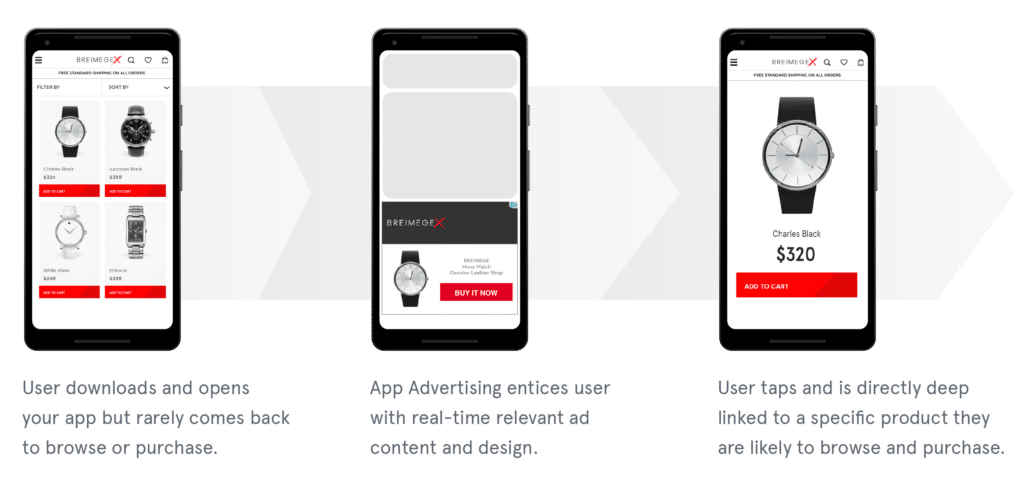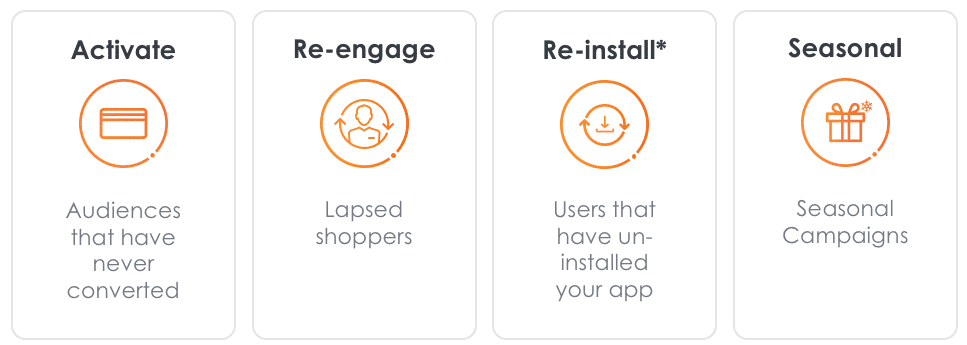App advertising
Mobile apps have become central to how people shop, connect, and engage with content, offering brands a powerful way to reach and interact with their audiences. But simply developing an app and encouraging downloads isn’t enough. To drive meaningful results, ongoing app advertising is key to keeping users engaged, fostering loyalty, and delivering a strong return on investment.
This glossary explores the essential concepts of app advertising, breaking down the why, what, and how of building successful campaigns. Whether you’re looking to engage app users who have never converted or maximize the value of active users, the information here will help you unlock the full potential of app advertising.
App usage and the post-download slump
Launching a shopping app can be a smart move, but it’s not a guaranteed path to success. Many users lose interest quickly. Recent studies reveal that, on average, only about 25% of users return to an app the day after installation, and this number drops to around 6% by day 30. By the third month, a significant majority of users have stopped engaging with the apps they’ve downloaded.
These statistics highlight the critical importance of effective user engagement strategies to maintain and grow your app’s user base.
Boost retention with app advertising
Though the retention numbers can look discouraging, they simply highlight the need for more communication with users to bring them back and keep them active. Our data showed that retailers that commit to an ongoing app promotion strategy are the ones that see the biggest in-app transaction growth.
One of the smartest ways to keep the momentum going is with app advertising, where targeted display ads reach app users wherever they are and drive them back to your app. There are different types of app advertising, including retargeting and engagement. Here’s how each works:
App retargeting
Say Bill is looking for a watch in your app but decides he isn’t ready to purchase just yet. As he browses, his intent data is captured, and after he leaves to visit another app, he sees an ad for the watch he was looking at, as well as some related products. He clicks the ad and is taken directly to the product page within your app to complete his purchase.

Retargeting is a highly effective way to keep users active after that initial app use. And once you’ve hooked them, shoppers are 30% more likely to return and shop within the app without further encouragement.
App engagement
App engagement campaigns allow you to target specific CRM or MMP audiences to re-engage lapsed shoppers. Similar to retargeting, these campaigns deliver dynamic display ads based on shopper data to entice them to come back to the app and convert.
Engagement campaigns can be used in a variety of ways, including to activate audiences that installed your app but never completed a purchase, to encourage users to re-install your app, to promote seasonal campaigns, and to re-engage app shoppers that haven’t bought anything for a certain period of time. For example, you could target a group of customers that haven’t made in purchase in the last 60 days with a coupon, or a special offer for a new product.
It’s a tactic that’s not to be ignored. According to a Google survey, 30% of app users said they would use an app again if they received a discount. Other incentives like offering exclusive content were also effective.

How to maximize app advertising performance
Not all app advertising campaigns are created equal. Here’s a checklist of capabilities you’ll want to make sure your app advertising partner can provide:
- Dynamic ads based on real-time individual purchase intent. Ads that only show the last product viewed or best-selling products are missed opportunities for marketers to engage individuals through other catalog items they are more interested in.
- Cross-device matching. A strong understanding of user behavior and purchase intent across devices and beyond walled gardens is crucial to delivering a cohesive and relevant experience. Inaccurate or limited cross-device matching can lead to wasted spend and ineffective ads.
- Broad reach. What’s the size of the network? How many apps could your ads appear on and across what exchanges? Obviously, the larger the scale, the more opportunities you have to connect with your audience.
- Dynamic creative optimization. Limited ad options in terms of size and creative can negatively impact performance. Personalized ads with a combination of visual elements tailored to engage each shopper will maximize engagement.
- Predictive targeting. Targeting by manually defined audience segments and app categories means you can miss opportunities to target valuable users because they didn’t happen to fit into any pre-defined audience segment. Look for a solution that allows you to target by individual behavior and purchase intent so that every high value user sees an ad.
Have more digital marketing questions? Visit our Insights section for education, trends, and tips.





